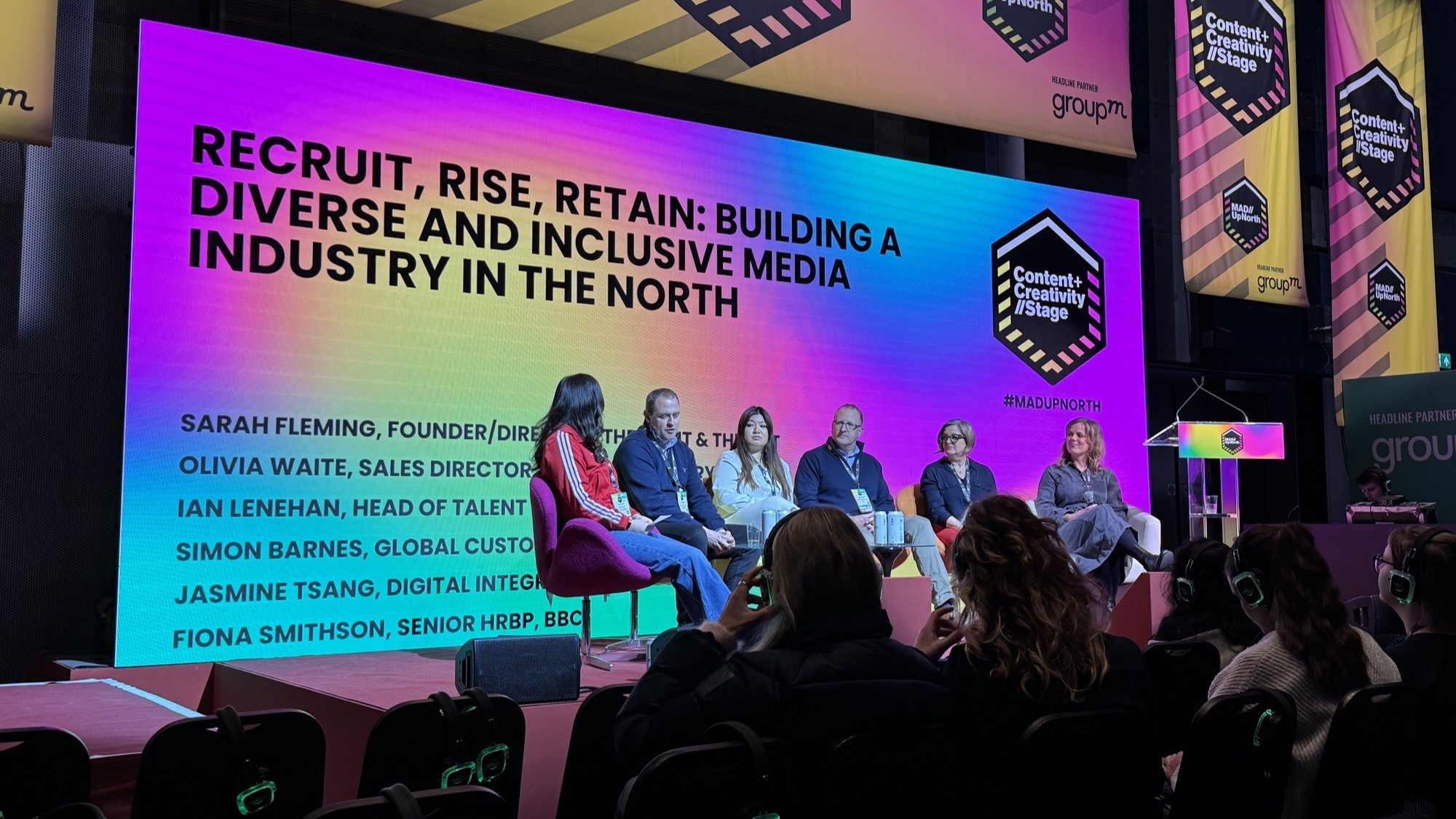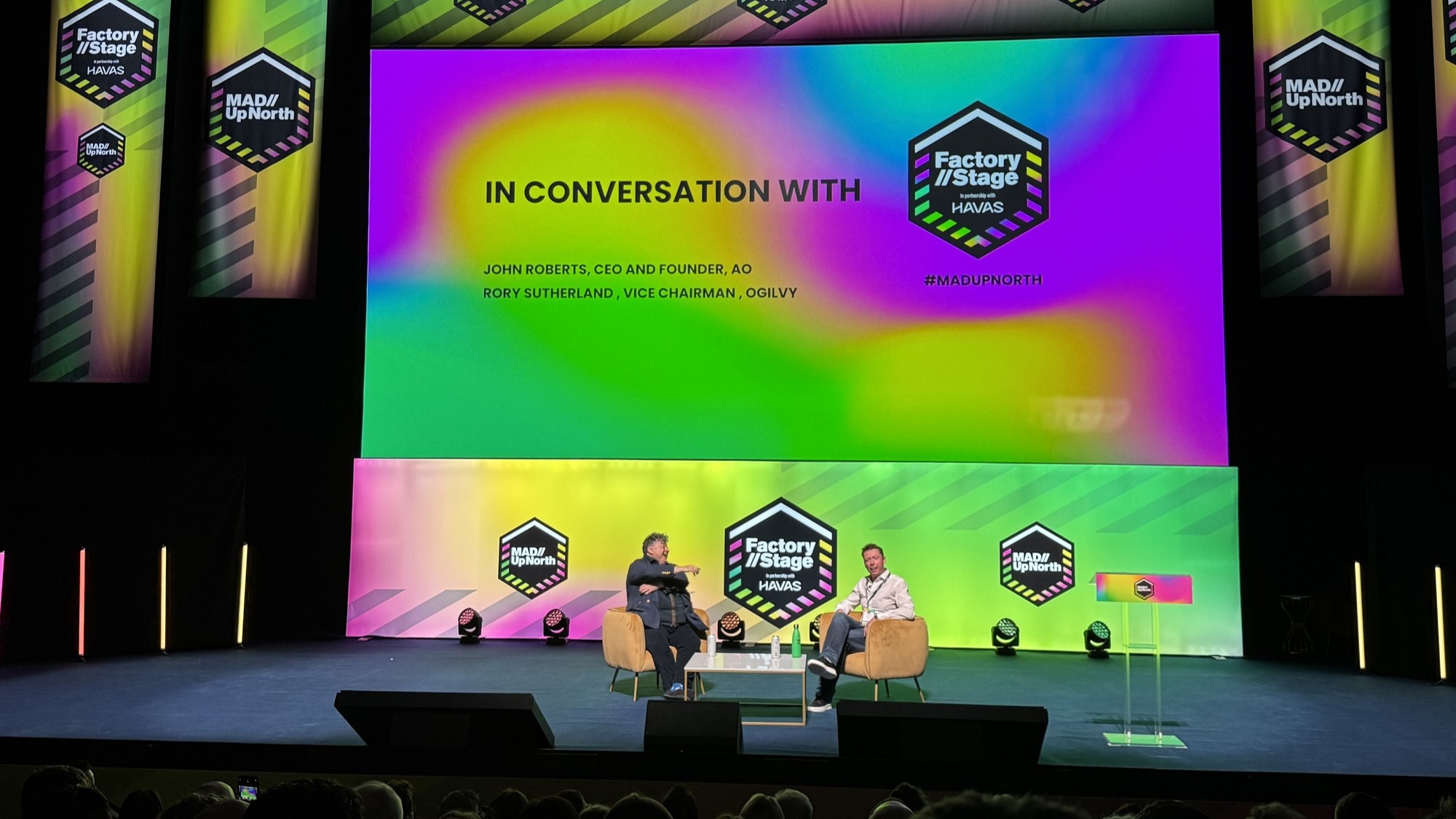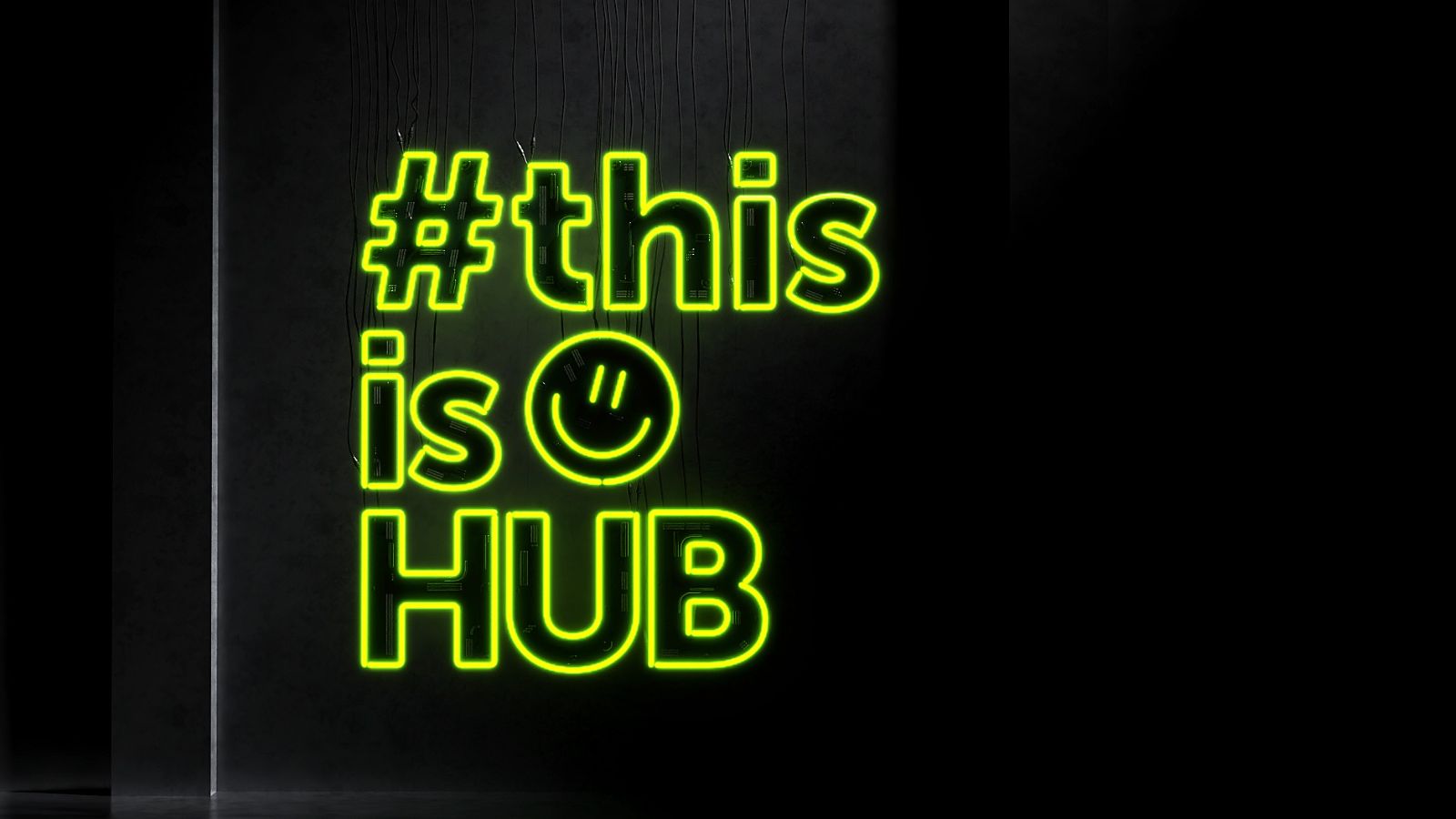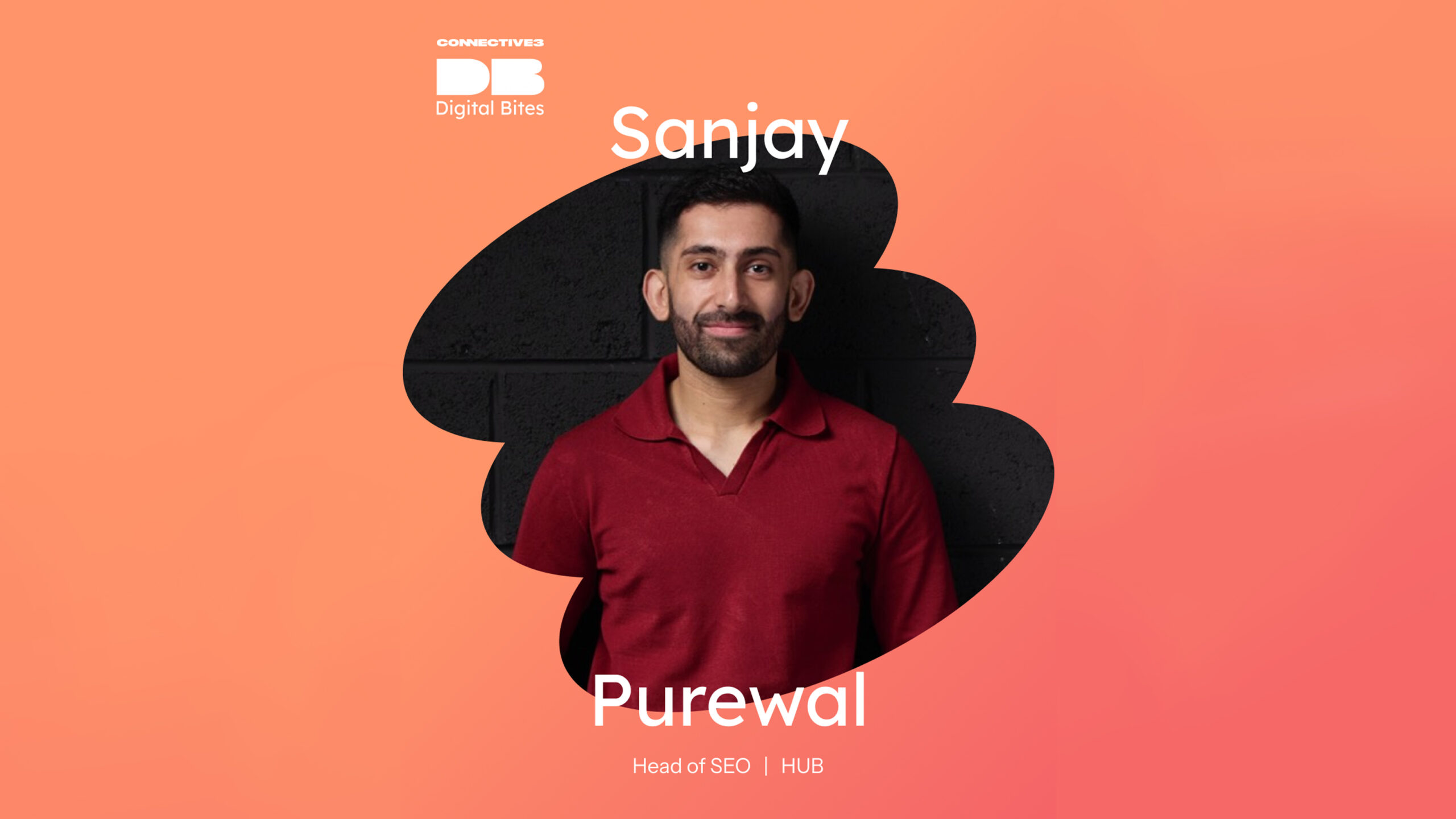After the *ahem* madness that was Day One of MAD//Up North, we ventured back over to Manchester for Day Two! While Wednesday had a focus on retail media, day two was all about content and creativity.
Interview with Gary Neville
For: Brand Managers, Entrepreneurs, HR and Business Owners
Speakers: Gary Neville; Justin Pearse (New Digital Age)
Opening up the Factory Stage on day two of Mad//Up North was Gary Neville. He spoke about what sets the north, Manchester specifically, apart from the rest of the UK, and where he sees grounds for optimism moving forward.
AI & content personalisation
He began his session by referencing his collaboration with Arwen, the UK tech firm using AI to block out harmful and offensive content from users’ news feeds. Neville said he preferred aggregating personalised content, and he hopes this will pave the way for how we consume news and other online content moving forward.
When asked if he envisions a future in which AI could be a sports pundit, he wasn’t quite so optimistic. Referencing his former manager, Alex Ferguson, Neville points out that “one thing you can never beat is the naked eye”. AI lacks the ability to perceive personality, atmosphere, and momentum shifts in real-time, he said, which are crucial in understanding the dynamic nature of football. AI also struggles to assess mood, emotions, and the intangible elements of a game. While he would like to bring forward the ability for AI to measure personality and character in recruitment, Neville acknowledges that AI still falls short and there are a lot of things that AI “can’t yet replicate.”
Mentorship and UA92
Neville placed a strong emphasis on the importance of diversity, inclusivity, a solid work ethic, and a positive attitude in building successful teams. He believes in surrounding himself with inspiring and hardworking individuals, with his own philosophy being shaped by mentors like Bryan Robson, Roy Keane, and Alex Ferguson, who instilled in him the values of showing up, working hard, and never giving in no matter how successful they got. Neville also emphasised the significant impact mentors and coaches have on shaping careers and lives, impressing that they play a vital role in personal and professional development – this is relevant across teams of all shapes and sizes, whether in sports or in business.
Neville also said he draws inspiration from the resilience of young people and is dedicated to reshaping education with his higher education institution, UA92. The focus at UA92 is on character and personal development alongside academics, with Neville asserting, “A degree gets you an interview, but character gets you the job.” He identifies key skills that young professionals need, such as resilience, leadership, and the ability to handle difficult conversations. For Neville, the ultimate goal would be to disrupt higher education by integrating personal development into curriculum, preparing students not just for exams, but for real-world challenges.
Lessons learned
When asked what his biggest mistake is, Neville didn’t even hesitate. “Valencia,” he said, followed by some light chuckles in the audience. For those who aren’t football fans, Neville was appointed Head Coach of Valencia in December 2015 and was sacked only four months later. He admitted that failing to say ‘no’ to the opportunity led him to take on the role, despite knowing he lacked the necessary coaching experience. What’s worse was that he accepted the position due to external pressure and knew that he didn’t have confidence in himself to deliver. Feeling out of his depth, he lost confidence and realised the importance of learning from setbacks. He felt “unbreakable” when leaving Manchester United on a high note, but his experience at Valencia quickly served as a “clip round the ear”.
Authentic content
Not only content with only showing his disdain for X earlier in the session, Neville has had enough of how algorithms and short-form content limit the depths of discussions on social media. Sky’s decision to remove non-live football content drove him to create The Overlap and Stick to Football, two multi-award-winning podcast series’ that deliver engaging, high-quality football content. His magic formula for content? Passion, authenticity, and the quality of guest speakers. “Authenticity is everything,” he said. “Content is about making sure you do something that taps into people or the problem”, whether that’s in an advert or in a podcast audience. In the advert, in the audience. He admitted that quality content does money, mentioning factors like production costs, wages, and inviting fans to debate, but says that monetisation is one solution to this. This time, he has admitted his shortcomings (or rather, he knows where his strengths lie) and has enlisted a third-party agency to monetise his content.
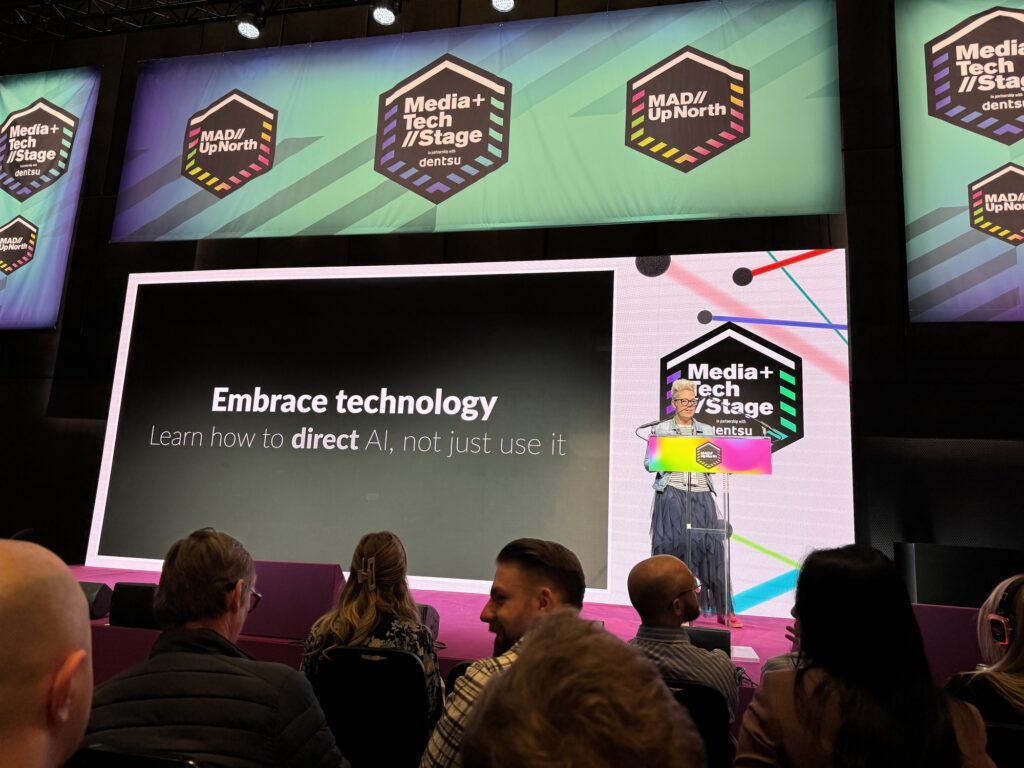
Creativity & AI
For: Creatives and Creative Directors
Speakers: Sabrina Godden (Vodafone)
Creativity vs. AI
“Just because AI lets you make a cat fly doesn’t mean you’re suddenly a creative genius.” That’s the opening statement from Sabrina Godden as she stands alongside an AI-generated picture of a cat with wings. Her point? Creativity isn’t about technology; it’s about pushing boundaries and connecting with audiences on a deeper level. AI is simply a tool that will help creatives meet this objective.
But here’s the kicker: creativity declines with age. At age 5, it’s at 95%, by age 10, it’s down to 30%, and by 35, it’s a mere 2%. The real challenge? How do we ensure that last 2% isn’t wiped out by AI? It’s easy to blame AI for the “sea of sameness” we see in the world., but Godden argued that homogeneity has always existed. From Instagram trends to fashion cycles, the problem isn’t the tools; it’s how we choose to use them. Godden assured us that the responsibility to create something fresh and exciting still lies with us.
AI as a tool
Instead of using AI for AI’s sake, Godden urged creatives to focus on the “why” behind their choices and be critical of AI’s output. According to her, the brands and creatives who will advance in the coming years will learn to direct AI rather than simply ‘using’ it passively. She proposes using AI top optimise creative workflow: Where are you wasting time? Where could AI step in to help? Evaluate the suitability of AI – just because it exists doesn’t mean it needs to be applied everywhere. In brainstorming sessions, Godden said that some team members have admitted feeling guilty about using AI, thinking it’s “cheating.” That’s a misconception, she said—AI is just a tool that helps bring ideas to life. Also keep in mind that the landscape of AI is constantly changing, so what works now might not work six months from now. She urged creatives to “learn with it”.
One huge advantage of AI according to Godden is the ability for creatives to scale and personalise their work while focusing on what really matters: strategy and storytelling. No more getting bogged down by repetitive tasks like resizing images or adapting content for different languages. AI will handle the grunt work, so “creatives can be creatives.”
At the end of the day, AI can assist, but it won’t tell our stories for us, said Godden. Authentic human experiences drive great storytelling. We can use AI to amplify and bring those stories to life, but we can’t rely on it to replace the core of creativity: the human touch.
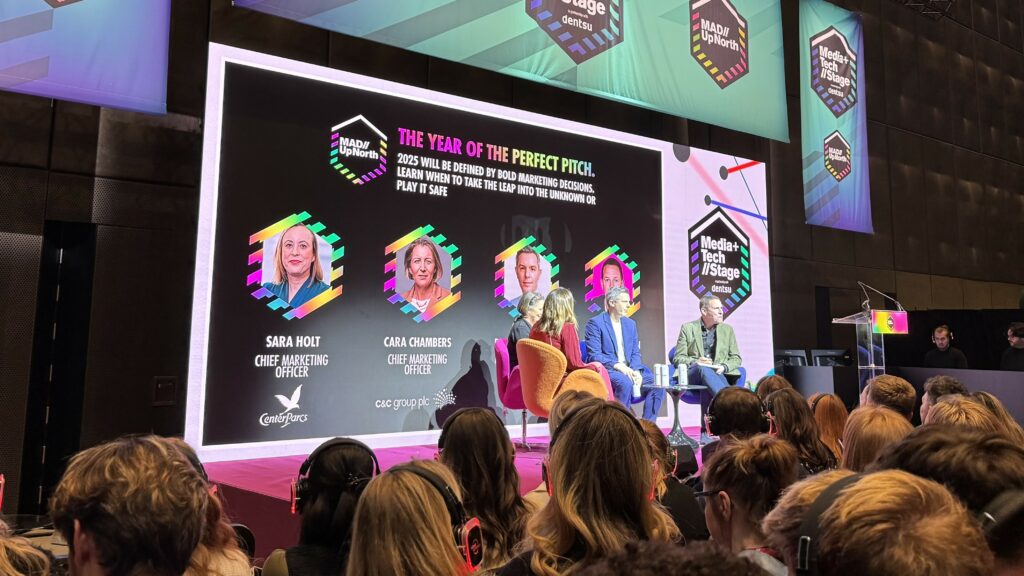
The Perfect Pitch
For: Marketers and business owners looking to engage marketing agencies
Speakers: Cara Chambers (C&C Group); Richard Bowden (No7 Beauty Company); Sara Holt (Centerparcs); Richard Robinson (The Ingenuity Group)
Perfect Pitch: Elevating Marketing to the Top Table
Businesses are waking up to the fact that long-term growth and transformation depend on successful marketing. As Sara Holt said, the demand for CMOs has never been higher. The new wave of marketing leadership needs agencies who aren’t just reactive but are out ahead of the curve.
Guinness: Crafting year-round relevance
Take Guinness, for example. This iconic brand knew it had to shift its perception from being a once-in-a-while drink to a year-round staple. The magic? It figured out where Guinness could show up in culture, adjusting its marketing mix to make it relevant across all seasons. They didn’t just stop there—they rallied their consumers to preach the gospel of Guinness. This was key to their always-on strategy, turning their loyal customers into passionate brand advocates.
Creativity, risk, reward and data
Creativity is always a calculated risk. As Cara Chambers puts it, it’s all about balancing the risk and reward of big creative leaps. In an environment where not everyone gets your vision, the secret is clarity. Define what’s not working, identify the problem, and let data guide your way. When resources are tight, creative pinch-points can be gold, especially with a limited media budget. Stick to your idea, and go wild with how you execute it. And always stay true to your brand’s roots while pushing boundaries within the brief.
From ‘Show the mettle’ to ‘Feel the mettle’
Holt told us that effective storytelling isn’t just about flair—it’s about deep understanding. Convincing the board at Alton Towers to trust in human ‘feel the mettle’ storytelling over the decades-old ‘show the mettle’ formula took research, data, and a whole lot of guts. This transition wasn’t just a creative leap; it was about tapping into the Alton Towers’ DNA and expanding that resonance to the audience. Deep, meaningful storytelling became their competitive edge—and Holt had to fight for it.
The agency’s role: Helping CMOs sell creativity
According to this panel, the best agencies ‘just get it’—they understand the drama a CMO faces in the boardroom and arm them with solid data and research to help sell their vision. By ensuring the information is robust and backed by proof, agencies give CMOs the tools to navigate tough pitches. It’s a matter of understanding the business needs and showing how creativity can move the needle in the boardroom.
Agency cultural alignment
When agencies truly understand their client’s culture, the impact is undeniable, said Richard Bowden. It’s not just about executing campaigns but about aligning with the client’s vision and values. According to Bowden (and we at HUB believe this too), the most successful partnerships come from mutual understanding—agencies that read the brief, live the consumer experience, and show they get it, are the ones that not only pitch but deliver.
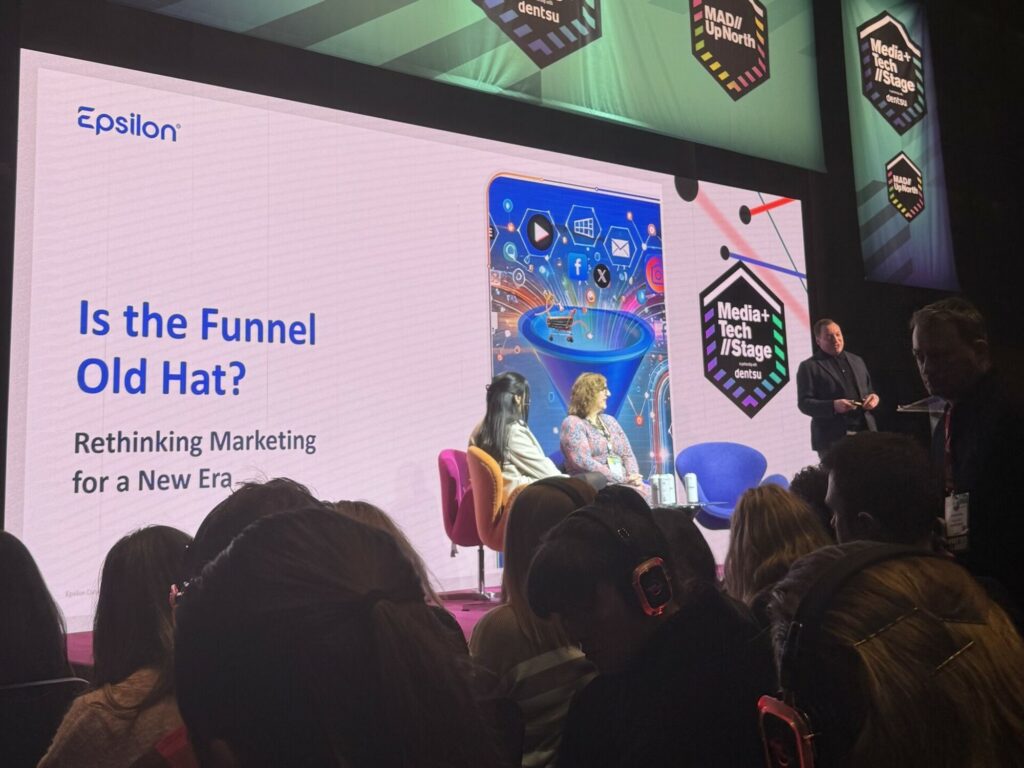
No Funnel, No Problem: The Future of Fluid Marketing
For: Campaign Managers and Customer Journey Strategists
Speakers: Elliott Clayton (Epsilon); Jess Clerke (John Lewis Partnership); Diana Abebrese (EPAM Systems); Katrina Smart (Mars United Commerce)
Marketing budgets are soaring, yet brands are facing a frustrating reality—performance is dipping at critical moments. Why? A major culprit is channel fragmentation, leading to inconsistent messaging and inefficiencies that weaken impact. In a landscape where customers are bombarded with content from all directions, retail media emerges as a powerful solution, offering unified messaging and sharper targeting to cut through the noise.
But here’s the challenge: customer journeys aren’t linear. As Jess Clerke points out, 60% of purchases happen online and 40% in-store, although these numbers shift depending on the product category. Consumers move seamlessly between digital and physical spaces, making it harder than ever to predict their next move. This is where AI-powered solutions and proof-of-concept (POC) initiatives step in, helping brands streamline and optimise interactions to keep pace with evolving behaviours.
Katrina Smart noted that omnichannel marketing is a top priority, but internal roadblocks can often slow progress. It is important to ensure all internal stakeholders believe that retail media is just one piece of the puzzle, not a standalone strategy, as highlighted by Diana Abebrese. For these panellists, the key to omnichannel success lies in consistency—brands must ensure messaging aligns across every touchpoint, avoiding contradictions that could confuse or alienate customers.
Ultimately, end-to-end campaign management presents a massive opportunity to boost efficiency and scalability, according to Jessica. By integrating retail media into a broader, well-orchestrated strategy, brands can maximise their marketing spend and drive stronger performance where it matters most.
Brands stop wasting your time with creators
For: Brands and agencies engaging influencers
Speakers: Ben Kaluza (Creator) and Oliver Yonchev (cocreatd.com)
We’re holding our hands up again – we only caught the last five minutes of this session. But these five minutes were actually really insightful, so we thought we’d share them with those of you who use or are considering influencer marketing as part of your channel strategy.
Ben Kaluza hit home the fact that not all attention is good attention, and that too many brands fall into the trap of partnering with creators who prioritise short-term views over authenticity. Disingenuous hooks might rack up engagement, but there’s no real way to measure the long-term damage of negative sentiment. When an influencer stirs controversy, that negativity doesn’t just stick to them—it sticks to brands, too.
The way brands connect with influencers also matters just as much as who they choose to work with. If you’re a brand wanting real impact, Kaluza recommends building direct relationships with content creators rather than simply relying on talent agencies. When brands invest in these connections, they foster trust, creative alignment, and long-term value instead of just another campaign.
Interestingly, he also said that several influencers actually prefer working directly with brands rather than through agencies—especially those who are genuinely passionate about a product or mission. The takeaway? If an influencer is reaching out directly, take notice. They’re likely more invested, which can lead to better content, deeper engagement, and a partnership that actually drives results.
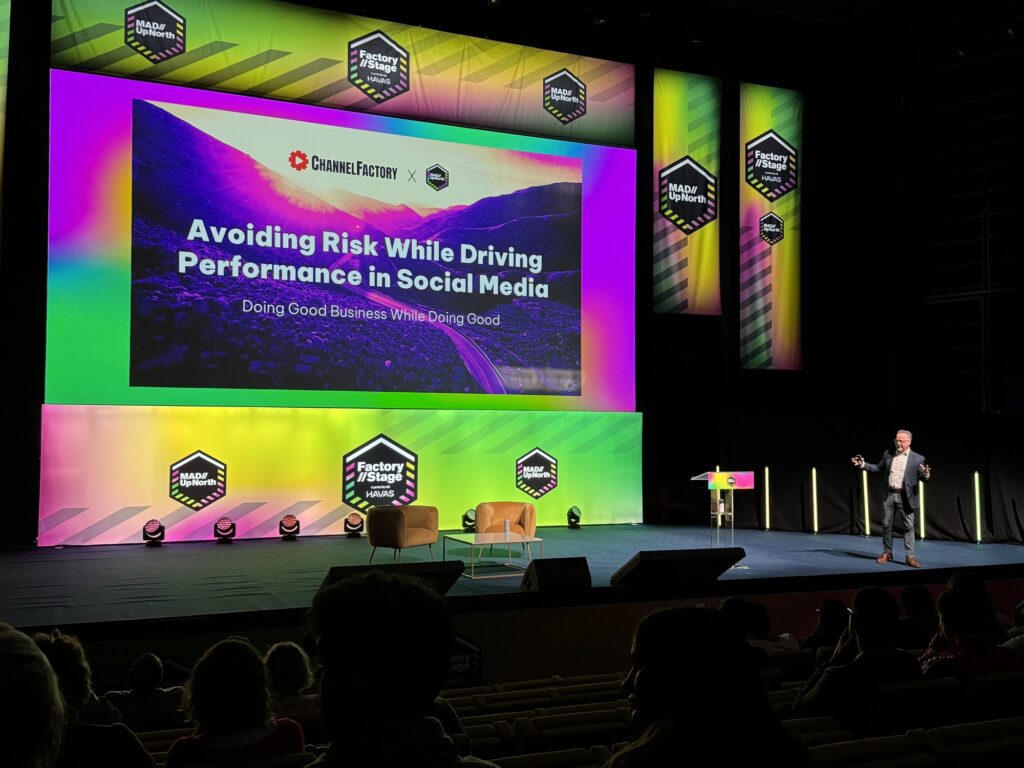
Channel Factory: Avoiding Risk While Driving Performance in Social Media
For: Brand and Paid Media Managers and Strategists
Speakers: Phil Cowdell (Channel Factory)
Phil Cowdell opened up his session with a picture of a mosque. This mosque was the site of a horrific terror attack which saw the gunman live stream his assault on Facebook for 17 minutes. The video, which depicted the death of 50 people, stayed up for three days following the gunman’s arrest, according to Cowdell.
It’s this incident, and the growing extremism of content on X, that is the driving force behind Cowdell’s session on responsible social media practices. His key tips for avoiding risk while driving social media performance are:
Brand safety floor
Elon Musk has once again sparked controversy, saying that advertisers who refuse to spend money on X are in fact blackmailing him. Facebook has also recently announced that it will no longer moderate its content. We, as advertisers, need to stand up to behaviour like this, according to Cowdell. Brands and advertisers must be proactive in ensuring their ads don’t appear alongside harmful content. Brand safety isn’t just a business issue—it’s about making sure our personal values aren’t compromised by business activities. “If you spend your money with a platform, hold them accountable,” he urged.
Brand adjacency
Where your ads appear matters just as much as what they say. Being placed next to unsuitable content can put a brand at risk, damaging trust and wasting ad spend. On the flip side, when ads are aligned with safe, suitable content, they drive better return on ad spend (ROAS) and overall performance. Smart placement isn’t just about avoiding risk—it’s about maximising value.
Inclusion and representation
Cowdell encouraged brands and advertisers to “bring politics and wokeism back into content,” as it’s a proven growth driver. He recommended looking at what keywords and search terms your brand ranks for, as this can give advertisers insight into what stance your audience is looking for you to take. For example, “is [product] vegan.” “Starbucks EDI policy.” “Does [beauty brand] test on animals.” “Is Pringles tin recyclable.” In today’s market, inclusion isn’t optional—it’s a competitive advantage.
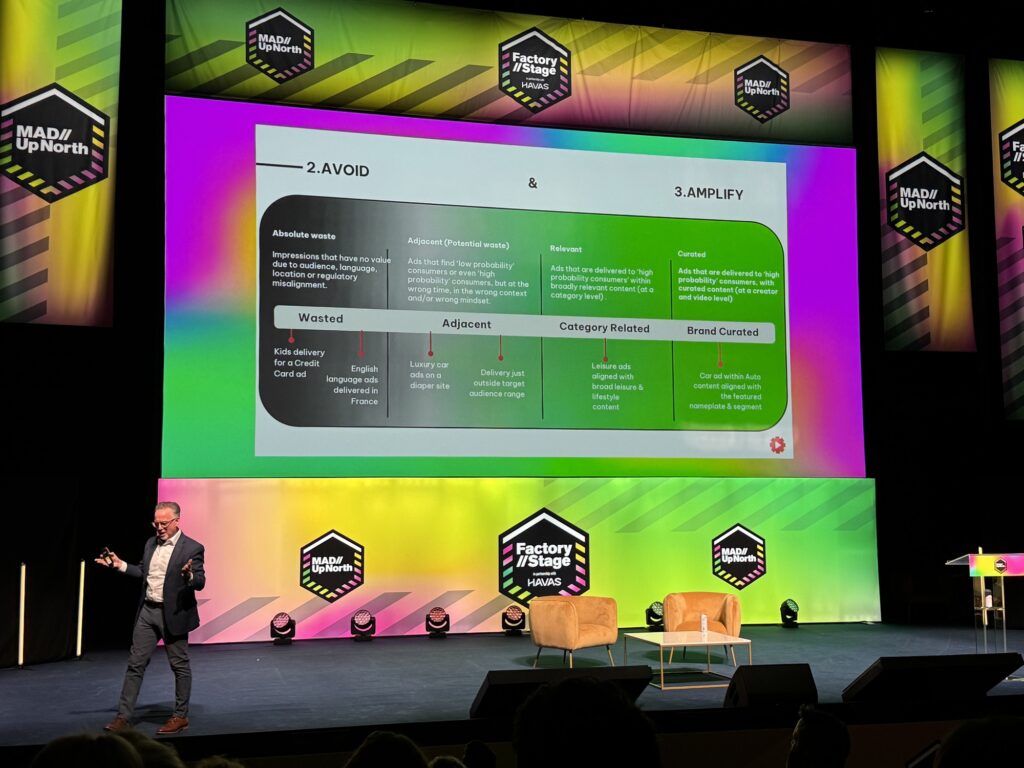
Environmental sustainability
Sustainability shouldn’t be seen as a cost. According to Cowdell, it should be seen as a performance driver. Brands and advertisers should adopt the “3As of sustainable marketing”:
– Audit their current marketing’s environmental impact
– Avoid marketing opportunities in which your marketing efforts will result in wastage, for example, ads that find ‘high probability’ consumers but at the wrong time. Cowdell used the example of advertising nappies on a luxury car site – while the viewer may actually need to buy nappies, that’s not why they are on the site.
– Amplify marketing opportunities and placements that have the highest probability of driving results, for example ads that find ‘high probability’ consumers with curated content. Here, Cowdell references a car ad embedded within automobile content that is aligned with the featured nameplate and segment.
Most importantly, Cowdell proposed a new metric for sustainable marketers: ROCO₂ (Return on Carbon Dioxide). He suggests this metric will measure the environmental impact of marketing and encourage marketers to advertise more responsibly.
Misinformation and fake news
The rise of misinformation is one of the biggest threats to both brands and society. Brands must actively filter out fake news from their ad placements and support responsible journalism. Algorithms shape public opinion, and with only half the world having the freedom to vote in democratic elections, media responsibility has never been more crucial. Where your ads land has a real-world impact—make sure it’s the right one.

Recruit, Rise, Retain: Building a Diverse and Inclusive Media Industry in the North
For: Internal marketers, HR, Business Owners
Speakers: Sarah Fleming (The Right & The Left); Olivia Waite (Channel Factory); Ian Lenehan (McCann Worldgroup); Simon Barnes (Jaguar Land Rover); Jasmine Tsang (Accenture); Fiona Smithson (BBC)
The corporate ladder in media (and most industries) is still an uneven playing field. For every 100 men promoted from entry-level positions, only 87 women make the same leap. This imbalance persists at every career stage, contributing to a glaring gender disparity in leadership. While three-quarters of women aspire to reach leadership roles, only 25-39% of C-suite positions are held by women. The ambition is there—the opportunities are not.
Widening the talent pool
Recognising the flaws in its recruitment process, McCann took a hard look at its hiring biases. Historically, the company favoured candidates with marketing degrees. McCann stripped applicant profiles of identifying characteristics to reduce unconscious bias, but they soon realized they weren’t reaching a truly diverse audience; just as corporate spaces struggle with diversity, so too do universities. Their solution? Expanding outreach to college students, removing the marketing degree requirement, and focusing on skills, passions, and personal attributes. They also moved away from a one-size-fits-all approach, introducing specialised programs to nurture talent more effectively.
Celebrating diversity
At Accenture, diversity isn’t just about awareness—it’s about celebrating differences, said Jasmine Tsang. Coaching sessions, particularly for women, help to develop career trajectories, while diverse talent is encouraged to be the face and voice of the brand – as Tsang was doing on the panel. Accenture is committed to unconventional talent pipelines, actively supporting non-graduate programs and initiatives like Girls in STEM, Girls Who Code, and Tech She Can. By ensuring young women see a place for themselves in tech and business, Accenture fuels excitement for future careers in these fields, said Tsang.
A top-down approach
Jaguar Land Rover identified a critical issue—women weren’t applying for leadership roles, particularly after maternity leave. Instead of waiting for candidates to step forward, the company adopted a proactive approach: leaders now actively recruit team members with the right skills for leadership, rather than relying on self-nominations. This shift has doubled the number of women in leadership roles. Gender pay gaps, once ranging from 11-20%, have been slashed to just 2% (which is still 2% too much, said Simon Barnes). More importantly, diversity discussions have become an open and ongoing part of the company culture. The impact? Lower attrition rates— which is now also under 2%—and a new focus on internal mobility, ensuring talented women continue progressing within the organisation.
Rethinking career progression
A survey at the BBC revealed a surprising insight: while staff retention was strong, employees felt stuck in their careers. Frustration over a lack of advancement was driving talent away. To address this, the BBC introduced two innovative career development initiatives. The ‘Hot Shoes’ program allows employees to try out different roles within the BBC for several days or weeks, providing exposure to new areas of the business. Meanwhile, the 80/20 program lets employees spend one day a week for 3-6 months in a different role, building skills in a safe, supportive environment. These initiatives aren’t just about retention—they’re about unlocking potential and ensuring career growth feels attainable for everyone.
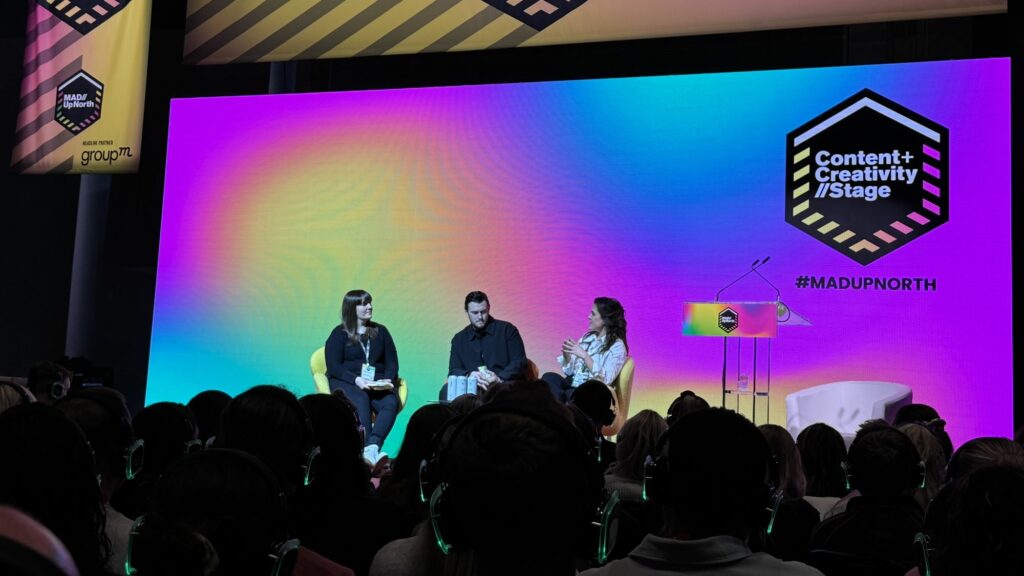
MADFEST Community: THE marketing buzzword, but what does it take to *actually* build a community?
For: Marketing/Event Managers and Strategists
Speakers: Melanie Goldsmith (Project30); Calum Watson (Gymshark)
Community isn’t just about a group of people—it’s about what connects them. Calum Watson of Gymshark defines it as shared passions, values, and experiences. It’s about creating a space where people feel seen and understood.
Influencers and creators shape communities through shared mindsets rather than demographics. Zoella’s audience, for example, isn’t defined by age but by common interests and values.
For brands, building community is tougher than for individual creators. Gymshark’s ‘Project 66’ shows how it’s done—keeping athletes and their communities at the core. The key? Making connections feel real, not forced.
Listening is non-negotiable, said Watson. Brands and creators must tune in, gather feedback, and act on it to keep engagement strong. But as they grow, maintaining that sense of belonging gets harder, said Melanie Goldsmith. Early adopters may expect one thing, while newer followers want something different—or the same level of intimacy that’s now harder to deliver. That’s where audience segmentation becomes crucial.
The solution? Get people involved. Initiatives like ‘Project 66’ turn passive followers into active participants, deepening their sense of belonging. Supporting community leaders is also key—Gymshark even helps cover bills for those driving real impact.
Since Covid, one lesson stands out: nothing beats face-to-face interaction. Gymshark embraces this with free gym classes at its stores, creating real, in-person connections. Accessibility is another challenge—while Nike can’t make LeBron James available, Gymshark’s heroes regularly engage with their community, making interactions feel personal and authentic.
For creators, just showing up isn’t enough. Real connections happen in the in-between moments, said Goldsmith. The best community builders get creative—like Sink the Pink, where performers immerse themselves in the crowd instead of staying on stage.
Finally, founders must step back as brands scale, said Watson. Early on, they embody the brand, but for long-term growth, the company must stand on its own. That’s how it continues to evolve and thrive.
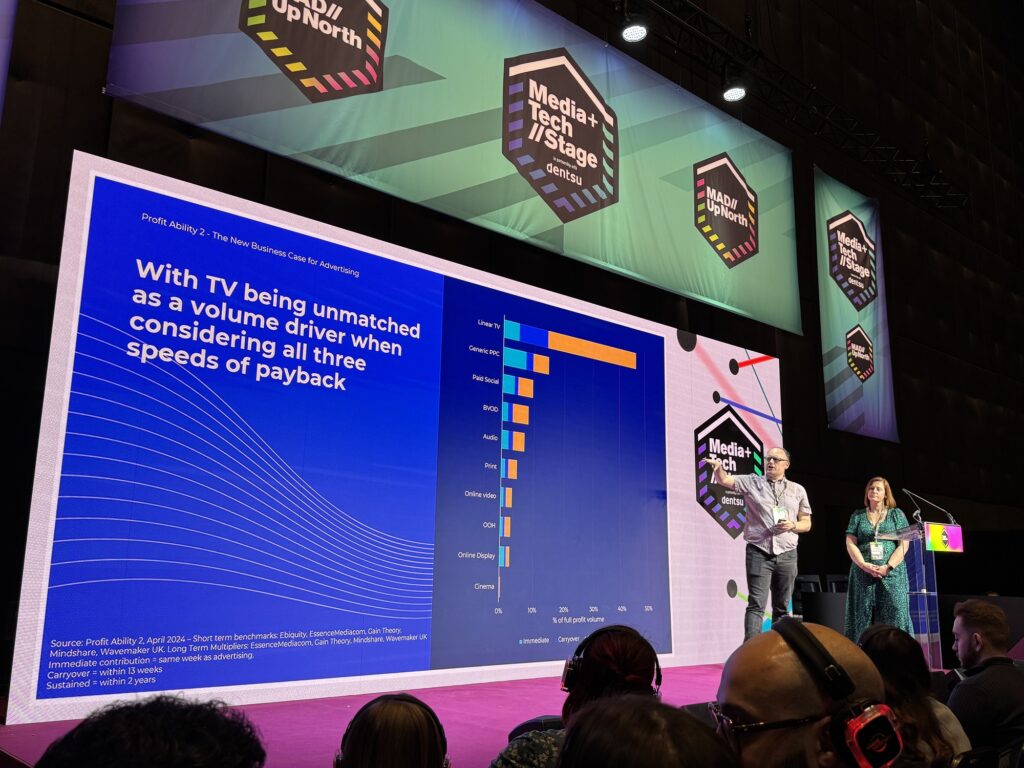
Profit Ability 2: The new business case for advertising
For: Media Marketers and Strategists
Speakers: Dominic Charles (Wavemaker); Ffion Turner (EssenceMediacom North)
Thinkbox’s ‘Profit Ability 2: The New Business Case for Advertising’ is the biggest econometric meta-analysis of advertising effectiveness ever.
It examines data from 141 brands, £1.8 billion in media spend, across 10 media channels and 14 business sectors (2021-2023). In this session, representatives from Wavemaker and Essencemediacom took us through the report highlights.
Advertising works – and it’s profitable
The study proves what marketers already know—advertising drives business growth. Every category analysed generated a positive payback.
- Short-term ROI: £1.87 per £1 invested
- Sustained ROI: £4.11 per £1 invested
What may surprise some advertisers (but not us) is that TV leads the pack. Linear TV + BVOD account for 54.7% of all advertising-generated profit with a staggering £5.61 ROI per £1 spent. Linear TV alone? 46.6% and £5.94 ROI. Plus, it has the highest weekly saturation point—advertisers can invest up to £330,000 per week before returns start diminishing.
Immediate payback isn’t just for performance media
Many assume quick returns come only from digital channels. This data says otherwise. Linear TV delivers the second-largest immediate payback (20.5%)—right behind Generic PPC (30.5%)!
Other strong short-term performers:
- Paid Social: 15.1%
- Audio: 8.6%
- BVOD: 7.3%
ROI varies by sector
Advertising is profitable across the board, but some sectors see bigger returns than others:
- Automotive: £4.65 full ROI per £1 invested—more than double Financial Services (£1.95).
- Retail (Large): £3.15 short-term ROI—nearly 3x Travel (£1.19).
Bottom line? Advertising pays off—but where you invest matters.
You can read the full report here.

Lessons from Greggs on how a brand from the north can take on the world
For: Brand Managers and Strategists
Speakers: Nichola Elgie (Drummond Central)
For the final session of MAD//Up North 2025, we settled down with Nichola Elgie to discover how Greggs transformed itself from an ordinary high-street bakery to one of the UK’s best loved brands. Elgie took us through her key staples of brand and campaign strategy:
Find your challenge
After the viral success of the vegan sausage roll, Greggs had to answer a tough question: what’s next? When launching the vegan sausage roll, they had the element of surprise on their side. They had to think much deeper when launching the vegan steak bake. Inspiration came from sneaker drops—keeping it fresh, exciting, and targeted at new audiences while staying true to their loyal customers.
Know your brand
“We want our customers to feel like they know Greggs as their best friend,” said Elgie. To do this, Greggs’ brand managers needed to understand what the brand stood for in the minds of their key audiences. They stay topical without being opinionated and always keep their authenticity intact. As they scale, their brand essence remains the same—relatable, fun, and unmistakably Greggs.
Know your channels
Reaching the right audience takes strategy—not just at brand level, but for every product. Greggs keeps things fresh by tapping into pop culture. Their PlayStation collab? A perfect fit for their accessible and affordable positioning. The Primark partnership? A cultural moment, with products flying off the shelves and reselling for 10x the price.
It’s not just about PR—earned media and unique real-life experiences, like the Greggs jewellery collection and Fender Unplugged events, set them apart. The key? Showing up where customers are—but doing it in a way that feels 100% authentic to the brand.
Know your internal stakeholders
Brand health isn’t just a nice-to-have—it’s a business driver. Greggs works closely with its agencies to track brand health through funnel metrics and prove marketing effectiveness, ensuring their marketing efforts contribute directly to both bottom line and high-level business growth.
Know how to be fun and distinct
Be the brand that competitors admire—but don’t just blend in. Creativity should stand out. Greggs thrives on playful partnerships, sparking online buzz and real-world conversations. If it feels right for the brand and gets people talking, it’s a win.
More than just sausage rolls
Greggs isn’t just selling food; they’re creating moments of joy. It’s about building emotional connections and doing it in a way that is unforgettable.
Avoid gimmicks
Authenticity is everything. Greggs doesn’t do partnerships just for the hype—they collaborate where values align. Primark? Both brands stand for affordability and fun. PlayStation? A natural crossover that resonated with both audiences. Every move has to make sense, or it’s not worth it.
Know where you can and can’t play
Growth isn’t about jumping on every opportunity—it’s about knowing where to show up and where to stay in your lane. Understanding these boundaries helps Greggs stay true to who they are while continuing to evolve.
